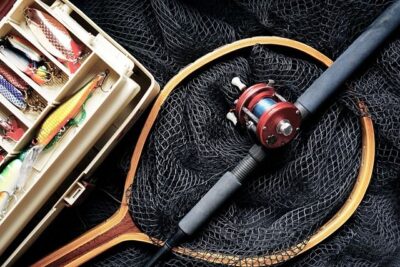Did you know fly reel backing is an essential angling accessory, yet one whose significance is often grossly underestimated?
Whether you’re shopping for your first angling gear or planning your next fishing expedition, it pays to spare some thought for fly reel backing. Read below as we delve into this resourceful fishing accessory.
What Is Fly Reel Backing?
Fly reel backing, also known as fly line backing, refers to the thin but remarkably strong section of the line at the back end of a fly line. The best way to grasp fly line backing is to familiarize yourself with the anatomy of a fly line.
Most modern fly lines are designed at a robust length and feature a core of braided Dacron or nylon. The core is coated with a strong and durable plastic, typically polyvinyl chloride (PVC).
The plastic coating, including microscopic glass spheres, is treated with various substances to enhance the line’s floatability.
A regular fly fishing line comprises two primary sections – the head and the running line.
The head consists of the line’s tip, belly, front taper, and rear taper. It’s technically the business end of a fly line.
Fly reel backing is the section that attaches to the rear end of the running line and secures directly to the arbor.

What Is The Significance Of Fly Reel Backing?
Fly reel backing provides extra leverage when tackling large or aggressive fish, such as tarpon and steelhead.
Aggressive fish species won’t go down without a fight. These fish can be tossed to and fro after securing them on a hook.
If you’re not properly grounded and the fish happens to be considerably powerful, you may quickly run out of line. Worse yet, you could be pulled into the murky water, leaving you profoundly regretting why you planned the angling trip in the first place.
Species like bonefish and permits are known to run up to 200 yards when fighting a fly angler. Comparatively, most fly fishing lines measure around 100 feet. That means even if your casts cover just 10 feet, the remaining 90-foot radius will still be insufficient when fighting a fish.
Besides improving your odds when tackling aggressive fish species, fly reel backing also increases the diameter of your reel spool. A higher reel pool diameter improves line retrieval speed.
How Much Fly Reel Backing Do You Need?
Most fly fishing reels are 100 – 125 yards long. The amount of backing you need will vary from one reel to another.
Three metrics are useful when calculating how much backing a fly line needs – your reel’s length, the backing diameter, and the target fish species. Longer and heavier backing provides better leverage with most fish species.
As a general rule, 50 yards of 20-pound backing will be great for trout fishing. Comparatively, steelhead fishing requires 175 – 200 yards of 20-pound backing or a little less if you use 30-pound backing.
If you’re targeting larger water game species, insist on 200 – 250 yards of 30-pound fly reel backing.
Experts also recommend choosing gel-spun backing over the traditional Dacron backing when targeting bigger or restive fish due to its enhanced capacity.
What Are Fly Fishing Backings Made Of?
Most fly reel backing is made from Dacron or gel-spun polyethylene (GSP). Each option has its distinctive strengths and weaknesses.
Dacron fly line backing is typically made from a tough polyester known as polyethylene terephthalate (PETE).
PETE is a synthetic resin used as a raw material to manufacture common plastics. You’ve most likely interacted with it in soda bottles and spinnaker sails.
Dacron stands out for its flexibility. When spooled in long strands, the material creates a low coefficient of friction. That makes it an excellent fit for fly reel backing.
But while effective for fly fishing, Dacron backing isn’t so eco-friendly. Gel-spun polyethylene would be a preferable option.
GSP is made from a polymer known as high-modulus polyethylene (HMPE) or ultrahigh molecular weight polyethylene (UHMWPE).
HMPE is developed primarily for use in body armor. It’s the primary material that constitutes bulletproof vests.
HMPE is also available in high-performance sailing lines and ultra-safe climbing ropes.
Despite their significantly reduced diameter, the polymer chains in HMPE stand out for their high break strength. That property gives GSP backing over 75% more capacity than its Dacron counterpart.
Besides the construction material, it’s also prudent to consider the weight of the fly reel backing before choosing this angling accessory.
Fly reel backing comes in a variety of test ratings. Again, this depends largely on the material the backing is made from.
Most Dacron backing are available in 20- and 30-pound test ratings.
How to Attach Backing
To attach fly reel backing, use a manual line winder or motorized rigging tool to wind a suitable amount of the backing material onto your fly reel.
Be sure to wind the backing uniformly around the arbor to secure it firmly during distant fish fights.
After securing the backing, attach the fly line’s rear end to the end of the backing.
Summary
The success of a fishing trip relies heavily on sufficient preparation. As many anglers would agree, a significant part of planning a fishing expedition consists of picking the right gear.
Although commonly overlooked, fly reel backing can enhance the capacity of your fly fishing line significantly. The backing can boost your angling odds, especially when targeting saltwater species.










 The 2024 virtual Men’s Round Table will be held Q4, 2024, date TBD.
The 2024 virtual Men’s Round Table will be held Q4, 2024, date TBD.













